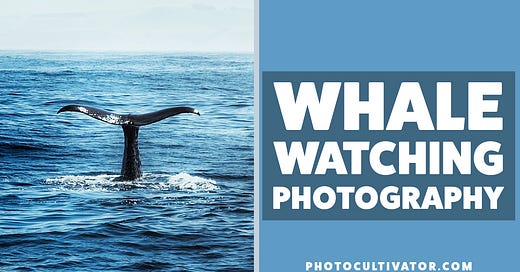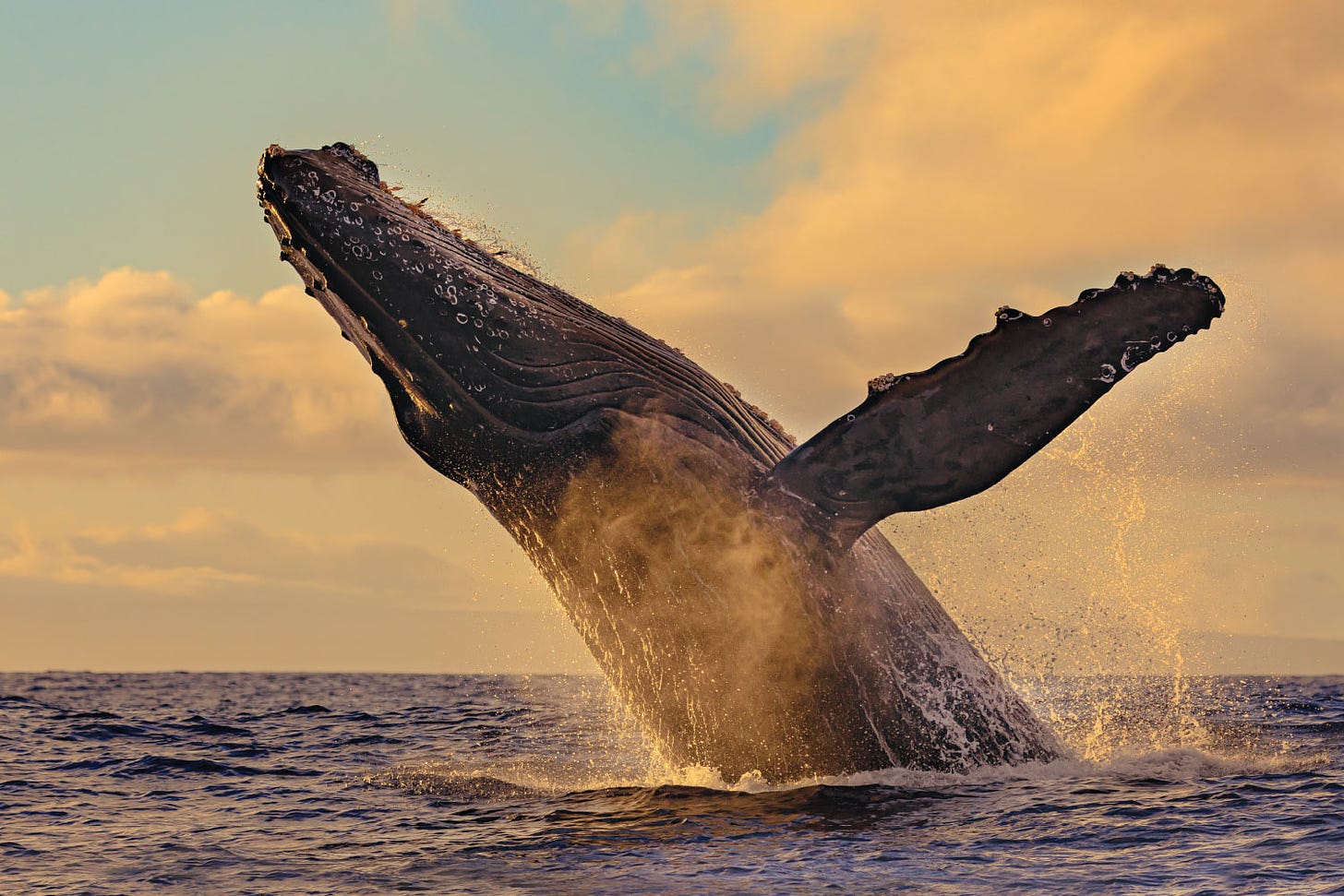The Ultimate Guide to Whale Watching Photography: Capture the Ocean's Giants
Whale watching is an incredible experience, and capturing these majestic creatures on camera is exciting!
However, photographing whales presents unique challenges that set it apart from other forms of wildlife photography.
The unpredictable nature of whale behavior, the constant motion of the boat, and the ever-changing marine environment all contribute to making whale-watching photography both challenging and rewarding.
Whether you're a seasoned photographer or a beginner, having the right gear and knowing the best techniques can make all the difference in getting that perfect shot.
Here’s everything you need to know to take amazing whale-watching photos.
Choosing the Best Camera for Whale Watching
When it comes to whale-watching photography, a camera with fast autofocus, good low-light performance, and weather sealing is fundamental.
Here are some top recommendations:
Canon Cameras
Canon EOS 5D Mark IV
Known for its excellent image quality and robust build, this camera is a great choice for serious photographers.
It offers a full-frame sensor and advanced autofocus system, making it ideal for capturing fast-moving whales.
Canon EOS R7
This mirrorless camera is lightweight and offers a high burst rate, which is perfect for capturing multiple shots in quick succession.
Its 1.6x crop factor can also help you get closer to distant subjects.
Canon EOS 90D
A versatile DSLR with a high-resolution sensor and fast autofocus, the 90D is a solid choice for both stills and video.
Sony Cameras
Sony A7 IV
Excellent all-rounder with fast autofocus and a 33MP full-frame sensor.
Sony A6600
Compact APS-C camera with great autofocus and 4K video capabilities.
Nikon Cameras
Nikon Z6 II
Full-frame mirrorless with fast burst shooting and robust weather sealing.
Nikon D500
Professional-grade APS-C DSLR with an excellent autofocus system.
Fujifilm Cameras
Fujifilm X-T4
Weather-sealed APS-C mirrorless with in-body stabilization.
Fujifilm X-H2
High-resolution APS-C camera with advanced subject detection autofocus.
For more detailed camera recommendations, check out my Beginner Photography Cameras Guide.
Best Telephoto Lenses for Wildlife Photography
A great telephoto lens is key for whale watching.
It allows you to capture detailed shots from a distance.
Here are some top picks:
Canon Lenses
Canon RF 100-400mm F5.6-8 IS USM
This lens offers a versatile zoom range and image stabilization, making it ideal for handheld shooting on a moving boat.
Canon 70-200mm f/2.8 L IS II USM
While this lens is known for its sharpness and fast aperture, you might want to pair it with a teleconverter to get more reach.
Sony Lenses
Sony FE 100-400mm f/4.5-5.6 GM OSS
Versatile telephoto zoom with excellent image quality.
Sony FE 200-600mm f/5.6-6.3 G OSS
Super-telephoto zoom for maximum reach.
Nikon Lenses
Nikon 200-500mm f/5.6E ED VR
Popular super-telephoto zoom at a reasonable price point.
Nikon 300mm f/4E PF ED VR
Compact prime lens that pairs well with teleconverters.
Fujifilm Lenses
Fujifilm XF 100-400mm f/4.5-5.6 R LM OIS WR
Weather-sealed telephoto zoom.
Fujifilm XF 150-600mm f/5.6-8 R LM OIS WR
Long reach super-telephoto zoom.
Third-Party Options
Tamron 150-500mm f/5-6.7 Di III VC VXD
Available for Sony E-mount and Fujifilm X-mount.
Sigma 150-600mm f/5-6.3 DG OS HSM Contemporary
Available for multiple mounts.
For more on telephoto lenses, check out my Nikon 55-200mm vs 70-300mm Tele Zoom Lens Guide.
Essential Whale Photography Tips
1. Use the Right Camera Settings
Shutter Speed: Set your shutter speed to at least 1/1000s to freeze the motion of the whales and compensate for the movement of the boat.
Aperture Priority Mode: Use aperture priority mode to control the depth of field and ensure sharp images. Set your aperture as high as the lighting allows to reduce the risk of out-of-focus shots.
Continuous Shooting Mode: Enable continuous shooting mode to capture multiple frames in quick succession, increasing your chances of getting the perfect shot.
For more on camera settings, check out my Essential Camera Settings for Beginners.
2. Master Your Positioning and Composition
Stay on the Deck: Shooting from the deck of the boat rather than at higher levels can make the whales appear larger and more impressive.
Choose the Right Spot: Position yourself at the back of the boat on the right-hand side. This area is usually less crowded, giving you more space to move around and capture different angles.
3. Be Prepared
Spare Batteries and Memory Cards: Always bring extra batteries and memory cards to ensure you don't miss any action.
Protect Your Gear: Use a camera bag or weather cover to protect your equipment from sea spray and rain. Saltwater can be particularly damaging to camera gear.
Practice: Familiarize yourself with your camera controls and practice photographing moving subjects, such as birds, to improve your skills before the trip.
For more tips on protecting your gear, visit my guide on How to Safely Clean Camera Lenses.
Composing Beautiful Whale Photos
Rule of Thirds: Place the whale's eye at one of the intersecting points of the rule of thirds grid. This creates a more dynamic and engaging composition.
Show the Environment: Include some of the surrounding seascapes to give context to the whale's size and habitat. A whale breaching with a distant shoreline or boat can provide scale.
Capture Behavior: Focus on capturing interesting behaviors like breaching, tail fluking, or spy-hopping. These dynamic moments make for the most compelling images.
Use Negative Space: Leave some empty space in your frame. A whale emerging from a vast expanse of ocean can create a powerful, emotive image.
Look for Reflections: On calm days, try to capture the whale's reflection in the water for a mirror-like effect.
For more tips on improving your composition, check out these 5 Simple Techniques to Improve Your Photo Composition
Ethical Considerations in Whale-Watching Photography
As photographers, it's important to prioritize the well-being of the whales and their environment:
Respect Distance: Always follow local guidelines on how close boats can approach whales. Using a longer lens allows you to keep your distance while still getting great shots.
No Flash Photography: Avoid using flash as it can disturb the whales and other marine life.
Be Patient: Never chase or harass whales for a photo. Patient observation often leads to the best, most natural shots.
Support Responsible Operators: Choose whale-watching tours that prioritize conservation and follow ethical guidelines.
Educate Others: Share your knowledge about whale conservation along with your photos to raise awareness.
Additional Tips from Experts For Whale Watching
“Think Like a Whale”: Anticipate where the whale might reappear by observing the direction it is headed and how fast it is going. Instead of fixating on where the whale disappeared, predict its potential path for a better chance of capturing remarkable moments.
Use a Circular Polarizer: A CP filter can cut through reflections and haze, making it easier to spot whales through the surface of the ocean and enhancing the visibility of their skin.
Manual Mode: While aperture priority mode is recommended for its ease of use, some photographers prefer manual mode to have full control over their settings. This can be particularly useful in changing light conditions.
And That’s It
Capturing the beauty of whales in their natural habitat is a thrilling experience that combines technical skill with a deep appreciation for nature.
These tips and recommendations will help you take beautiful whale-watching photos.
Whale watching photographer
We'd love to see your whale-watching photos!
For more tips on wildlife photography and gear recommendations, explore our other guides on capturing nature's wonders, such as my Best Cameras and Lenses for Safari and Best Tripod and Gimbal Head for Wildlife Photography.




